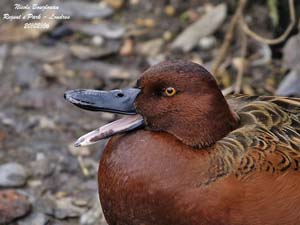
The different bills’shapes - Page 2
Show me your bill, I will know what you eat!
Aquatic birds such as Anatidae, (ducks, geese, swans and others) have peculiar bill with lamellae on the edges of the mandibles.
Many ducks feed on vegetation on the shore or dabble into the soft mud to search for seeds or aquatic plants. These species can filter the mud through the lamellae, in order to keep only the food items.
Photographers:
Bob Moul
Nature Photography
Steve Garvie
RAINBIRDER Photo galleries
Niraj V. Mistry
Photo Galleries
David Nowell
Virtually Home - Photo Gallery
Patrick Ingremeau
TAMANDUA
Callie de Wet
GALLERY
Nicole Bouglouan
PHOTOGRAPHIC RAMBLE
Text by Nicole Bouglouan
Sources:
L’ENCYCLOPEDIE MONDIALE DES OISEAUX - Dr Christopher M. Perrins - BORDAS - ISBN: 2040185607
See the article: Description of the bird and its plumage

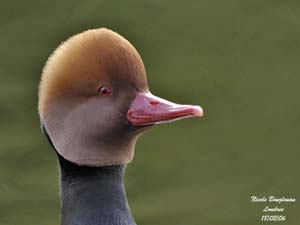
Anas cyanoptera
Red-crested Pochard
Netta rufina
Geese often feed in drier areas, and the strong bill with cutting edges allow them to cut the grass when they are grazing on the ground.
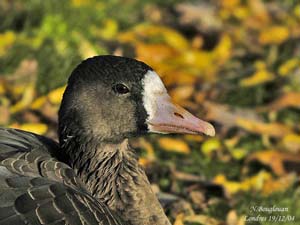
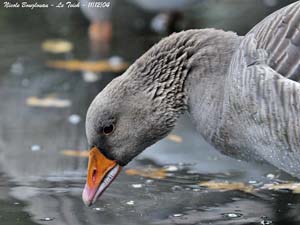
Greater White-fronted Goose
Anser albifrons
Anser anser
On the other hand, the mergansers have narrow, serrated bill, making easy for them to catch small fish.
They usually are more rapid and active than other ducks’ species.
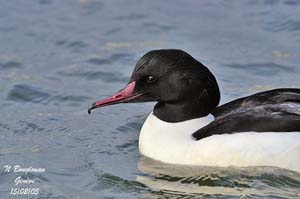
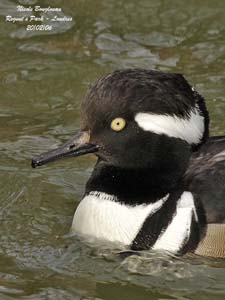
Mergus merganser
Hooded Merganser
Lophodytes cucullatus
Aquatic birds such as Ardeidae (herons, egrets, bitterns and night herons) have long, straight, dagger-shaped bill. These birds feed on fish, molluscs and other vertebrates and invertebrates, both aquatic and terrestrial, including small rodents.
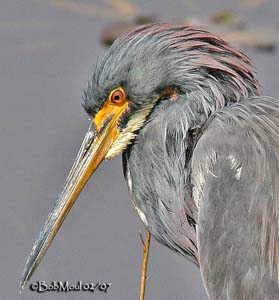
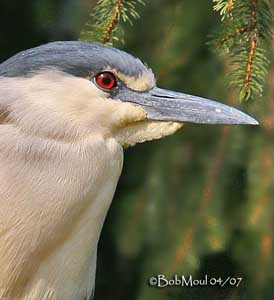
Egretta tricolor
Nycticorax nycticorax
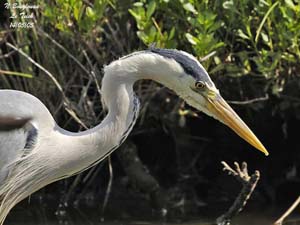
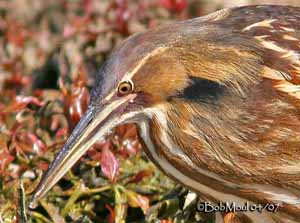
Ardea cinerea
American Bittern
Botaurus lentiginosus
The prey is jabbed with the bill while the bird walks slowly at water edge or waits motionless for a prey passing by.
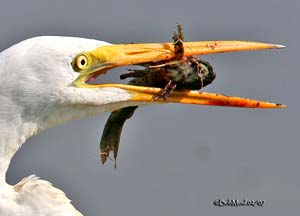
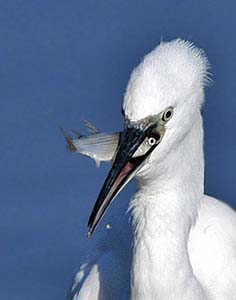
Egretta alba
Egretta garzetta
But other birds’ species have such bill. Storks also have long, straight, pointed bill. They quickly catch the prey with the bill, but usually, they do not jab it.
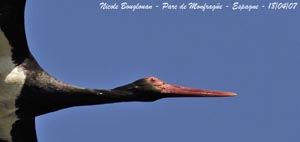
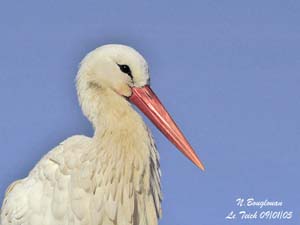
Ciconia nigra
Ciconia ciconia
Cranes have a long, straight bill too, and use it rather than the storks. They catch the prey with the bill tip. They also dig into the soil in order to extract seeds and invertebrates. They probe in the same way in the wet areas to feed on roots and stems of aquatic plants.
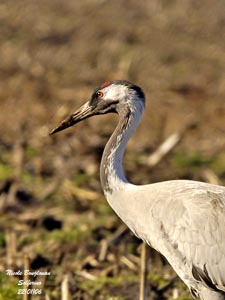
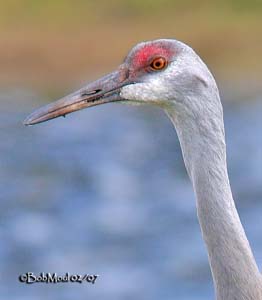
Grus grus
Grus canadensis
Other aquatic birds have almost the same feeding behaviour, but the bill is different. Ibises have long, curved bill, allowing them to probe into the mud or the soil for food.
To feed, they walk slowly in shallow water while foraging. They sweep their bill from side to side, and probe at the bottom, to find aquatic invertebrates. They also forage on mud or short grass, finding prey by touch, while probing, or by sight.
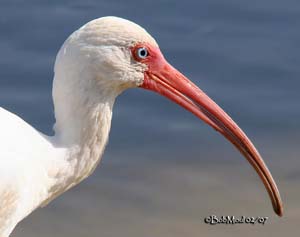
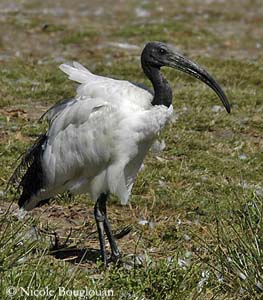
Eudocimus albus
Sacred Ibis
Threskiornis aethiopica
The species living in dry areas perform the same behaviour but into cracks and fissures in the earth.
But the strangest bill belongs to the spoonbills. The bill is spatula-shaped, with flat, broad and rounded tip, and well adapted to their feeding behaviour.
They fish "with the touch", while walking slowly, with the bill constantly immersed, performing long half circles from side to side, sweeping the fishing area to capture preys.

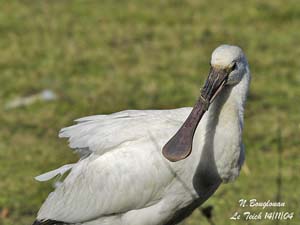
Ajaia ajaja
Eurasian Spoonbill
Platalea leucorodia
We have to mention the very well adapted bill of the Asian Openbill and the African Openbill. Both have an open bill formed by a hollow in the lower mandible. Both mandibles meet at tip.
These birds feed on large aquatic snails which live in wet areas. The prey is located by touch and sight. The gap in the bill allows good grasp of the snail’s shell.
Openbills walk slowly in shallow water, searching for prey. They extract the snail from the shell with the pointed lower mandible.
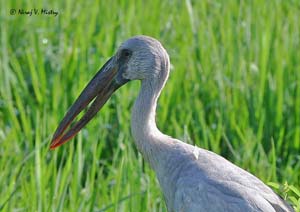
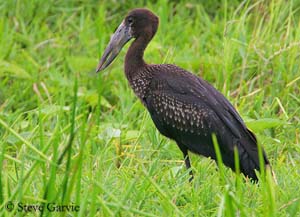
Anastomus oscitans
Anastomus lamelligerus
This amazing bird will be the conclusion of this page.
The Shoebill has stunning bill of up 21 cm length, and 10 cm width. It is a huge structure, with sharp curved hook at tip. Very sharp edges in mandibles allow capturing and cutting up prey before swallowing it.
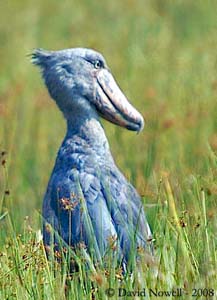
Balaeniceps rex
One more time, each shape is very well adapted to the behaviour of the bird. Only looking at the bill, we can know what its favourite food is, and how it can get it!
Another stunning bill is that of flamingos.
The bill is adapted for its unique feeding method: it is held upside down in the water, and swept back and forth, in order to filter out the tiny organisms.
The bill is bent sharply downward with filtering structure. The upper jaw fits into the lower jaw like a box lid. The fleshy tongue works to and fro like a piston. The tongue is covered with bristles like projections that help to filter water, mud and food particles through the lamellae.
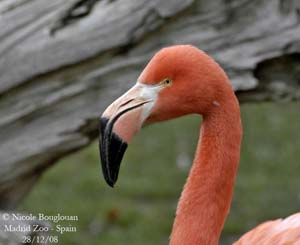
Caribbean Flamingo
Phoenicopterus ruber ruber
Pelicans show different behaviour while feeding.
The bill has a distensible gular pouch on the lower mandible. The pelicans plunge their bill into the water, in order to fill up the gular pouch, and then, they filter the water with semi open bills, and swallow the fish head first.
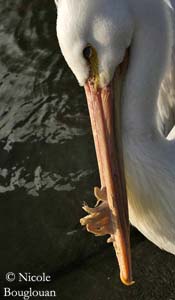
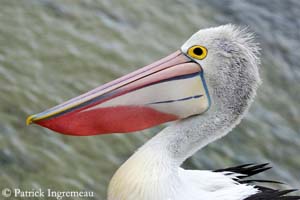
Pelecanus erythrorhynchos
Pelecanus conspicillatus
Only one member in the Family of Scopidae, the Hamerkop has long, heavy bill. It is deep and laterally compressed. Culmen is ridged and ends in slight hook at tip.
The bird uses the thinner lower mandible to cut up prey or vegetation, or any food item.
This peculiar bill is a response to the bird’s feeding requirements.
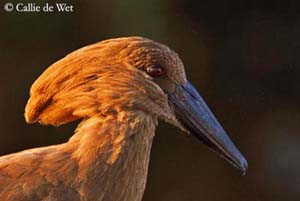
Scopus umbretta
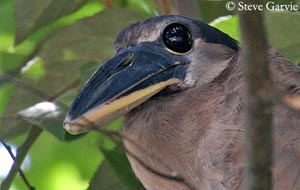
Cochlearius cochlearius
The Boatbill has remarkably broad and heavy bill, of about 7, 5 cm long and 5 cm wide.
This large broad bill is used as a spoon, to catch motionless preys. It seems to be very sensitive, and it opens at the merest touch.